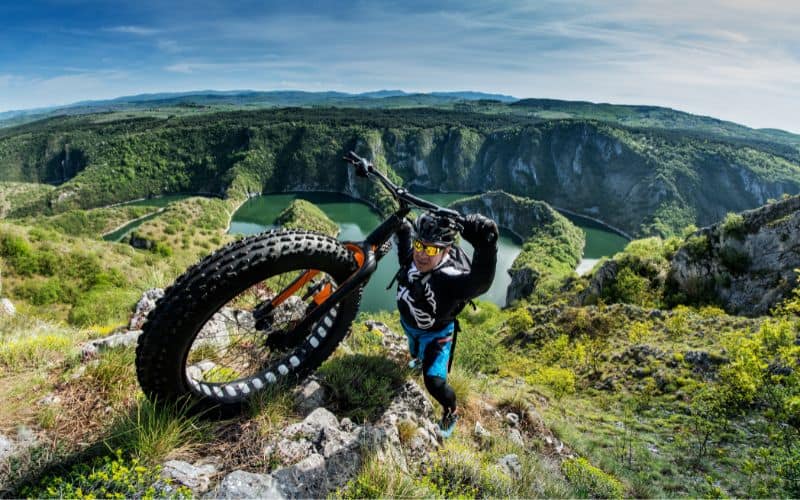With all the different options for cyclists, it can be hard to decide which bike is the best for your needs.
And when it comes to cycling over rough terrain, the two bikes that have grrown popular over the past few decades are mountain bikes and fat bikes.
However, which is better for riding over rough terrain?
We’ve found that you can, in fact, mountain bike with a fat bike. However, there are pros and cons to this, so join us as we dive into the details below!
Contents
Can You Mountain Bike with a Fat Bike?
Yes, you can!
In fact, a fat bike can make it easier to bike on soft and slippery terrain, so if you only have a fat bike, it will work in a jiffy.
However, if you want to build more technical skills or have something lower maintenance, a mountain bike is the way to go.
What Is a Mountain Bike?
First things first, let’s dive into the definition of a mountain bike.
A mountain bike is a type of bicycle specifically designed to endure rough terrain so you can ride it anywhere – especially on mountains!
Mountain bikes are known for having certain features that help them survive rough terrains, including:
- Tough wheels
- Adjustable suspension
- Heavy duty brakes
- Knobby tires
- A strong frame
- A straight handlebar
Although there are several subcategories of mountain bikes, these are the features that are often shared between them.
There are also different ways to classify mountain bikes.
First, mountain bikes can be classified by the type of suspension they offer.
There are three main types of suspension:
- Rigid: there is no suspension.
- Hardtail: there is a suspension fork.
- Full suspension: there is a suspension fork as well as rear suspension.
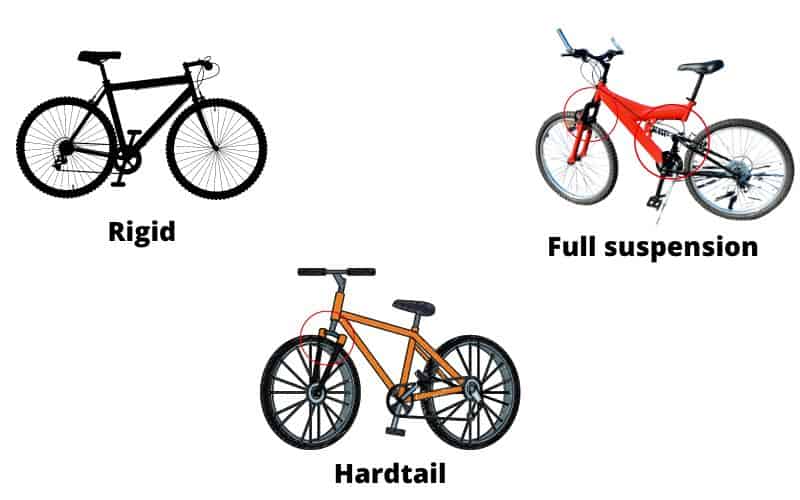
Second, mountain bikes can be classified by the type of terrain they are best suited for.
There are four main types of terrain-specific mountain bikes:
- Cross country: a light bike ideal for fast and uphill riding.
- Trail: a bike equally ideal for both uphill and downhill riding.
- Enduro: a multi-geared bike ideal for uphill and downhill riding
- Downhill: a swift bike ideal for downhill riding only.
As for the specifications of a mountain bike, there are several standards:
- Tires typically range between 48 and 66 millimeters in width.
- Rims typically measure around 30 millimeters in width.
- Wheels typically measure 26 inches in diameter.
- Hubs typically measure around 142 millimeters in width.
What Is a Fat Bike?
Now that we know what a mountain bike is, let’s look at the definition of a fat bike.
A fat bike is a type of bicycle with extremely wide tires that makes off-road riding easier with their higher traction.
A fat bike has several common features, such as:
- Wide tires
- Low tire pressure
- A heavy, wide build
- A rigid frame
- Powerful gear ratios
The defining feature that sets a fat bike apart from other types of bicycles is its wide tires, which act as a suspension system for the bike.
However, despite being wider than most bicycle tires, a fat bike’s tires are often under-inflated. This is because under-inflating the tires results in a lower wheel pressure.
Paired with wide tires, lower wheel pressure increases traction. This combination makes it easy for a fat bike to roll over soft or slippery terrain.

The wide, under-inflated tires make a fat bike more stable but slower, so the speed will depend on the rider’s power.
This tire setup makes it great for beginners, especially those who want to go on expeditions or tours.
As for the specifications of a fat bike, there are several standards:
- Tires typically range between 96 and 132 millimeters in width.
- Rims typically measure 66 millimeters or more in width.
- Wheels typically measure between 26 and 27.5 inches in diameter.
- Wheel pressure typically ranges between 5 and 14 psi.
- Hubs typically measure between 170 and 190 millimeters in width.
Mountain Bike vs. Fat Bike: Breaking It Down
Now that we are familiar with the definitions of both mountain and fat bikes, let’s compare the two!
1/ Usage
First, let’s look at the best ways to use mountain and fat bikes.
A mountain bike is great for a variety of uses, especially in difficult, rocky terrain.
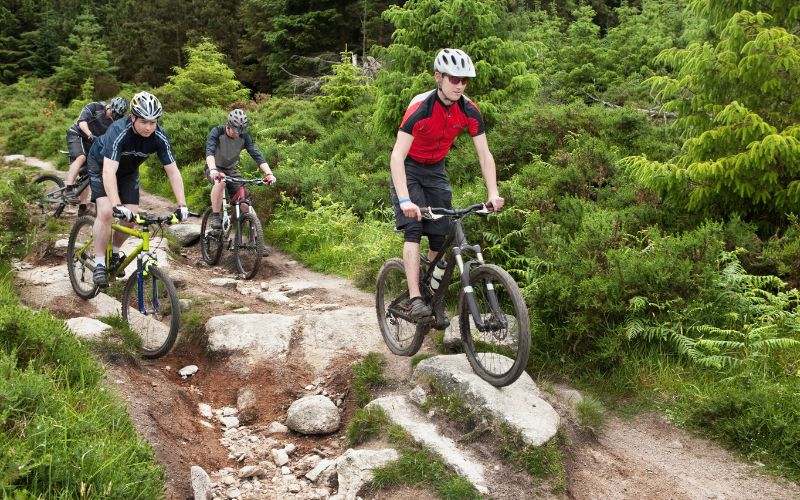
This is because of how quickly it can respond to any maneuvering, along with the fact that it has more gears than a fat bike.
However, a mountain bike isn’t an excellent choice for soft or slippery terrain. Its tires don’t have enough traction for this kind of terrain, so it often slips or sinks.
A fat bike is suitable for rugged terrain as well, and it has the added benefit of being able to ride on terrain that most mountain bikes aren’t built for.
Due to its higher traction and cushioning, it can ride easily over snow, ice, and even deep sand and mud. It can also ride in a wide variety of weather, whether you’re on or off the road.
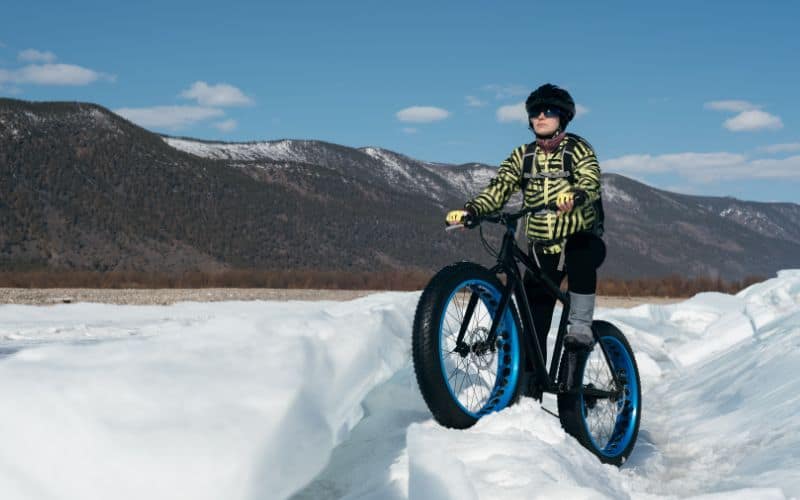
However, it responds slower than a mountain bike, making it best for terrain that doesn’t require quick reflexes.
2/ How They Work
When it comes to riding, there are significant differences between a mountain bike and a fat bike.
A mountain bike has a lightweight build, making it easy to ride, even at high speeds.
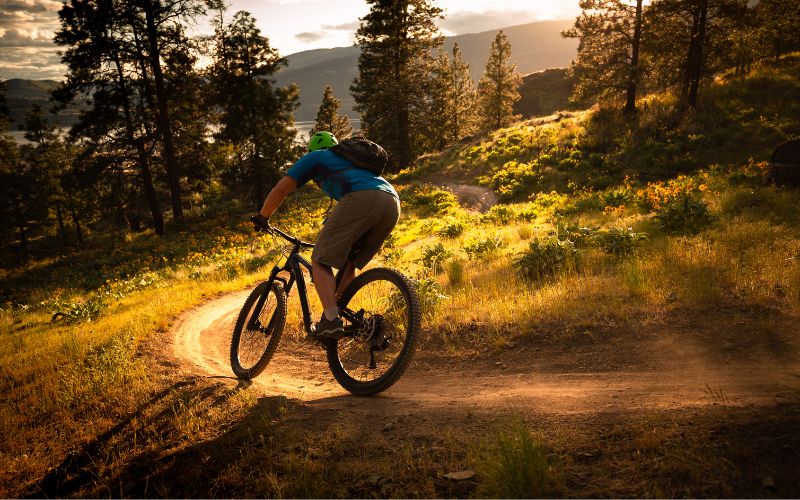
Because of its hard, narrow tires, it has low rolling resistance, making it easy to maneuver and efficient to power.
However, the tires also result in a bumpier ride, especially if your mountain bike doesn’t come with a suspension system.
The tires also mean you’ll need more skill in avoiding obstacles since their narrowness makes them easier to damage.
But an upside to the hard tires is that they don’t need much maintenance in terms of tire pressure. All you need to do is check the tire pressure before riding, and you’re good to go!
A fat bike has a heavy build, making it slower and more challenging to direct when riding.
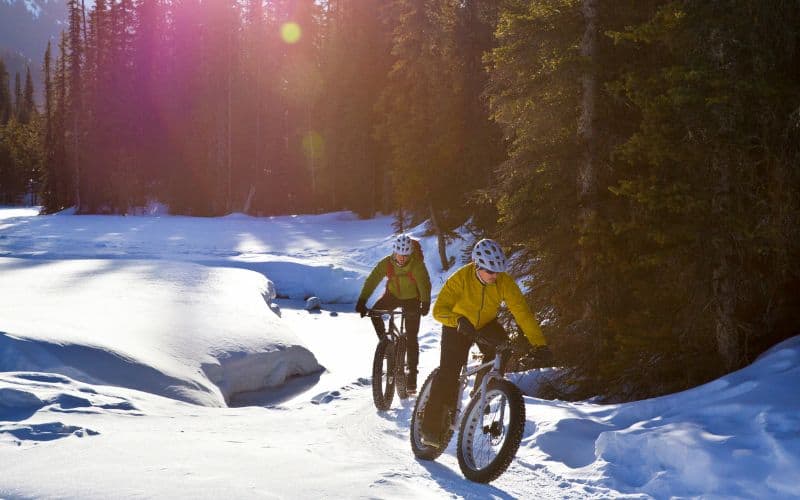
Because of its soft tires, a fat bike has high rolling resistance, making it hard to maneuver and very tiring to ride – especially on roads.
However, its tires also make for a smooth ride where you can simply roll over obstacles without worrying about sliding or causing damage to your wheels.
The only caveat is that its tire pressure is more of a hassle to maintain since it’s best to adjust the pressure as the terrain varies.
3/ Affordability
In terms of affordability, the price ranges differ between mountain and fat bikes.
Mountain bikes are extremely popular, which means there are a wide variety of brands and builds.
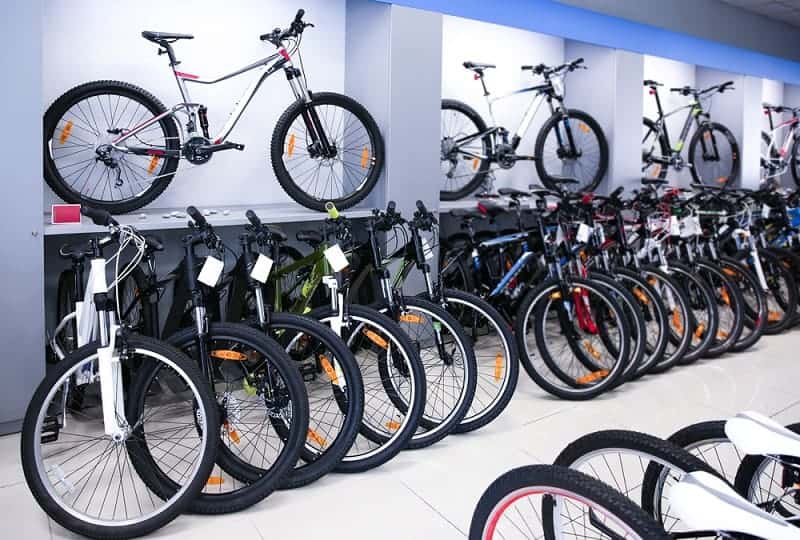
Due to the variety, it is easy to find mountain bikes on both the low-end of the price spectrum as well as the high-end.
It is also easier to find replacements and options for their frames and tires, which means you don’t have to pay extra for a rare part.
Fat bikes are still a niche hobby, so they’re best seen as an investment due to their ability to ride over a wider variety of terrain.
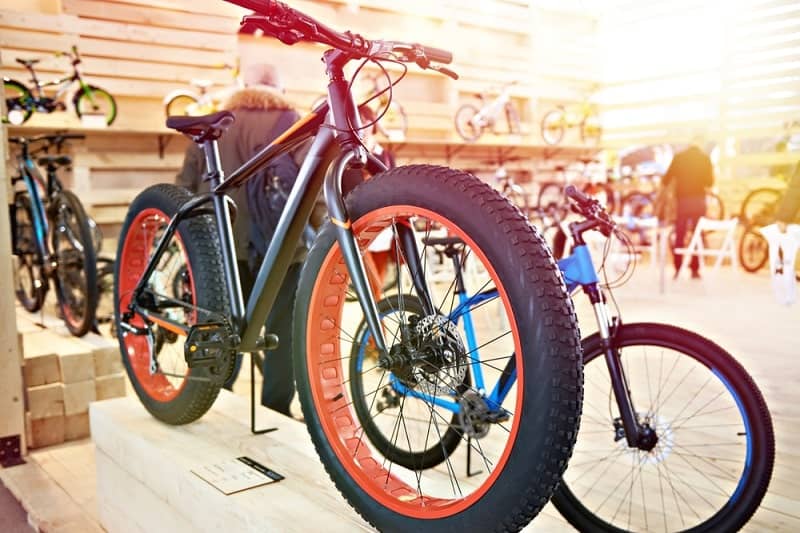
And because they’re not as popular as mountain bikes, it’s also harder to find different customizations and parts, so you may have to shell out more money to get your fat bike repaired or customized.
4/ Safety
Let’s not forget that safety is a big factor, especially if you’re a beginner!
Mountain bikes are light and fast, making them great for riding but not as great for safety.

Because of their light build, they can be easily blown by strong winds, making them dangerous to ride in bad weather.
And because of their speed, they make it harder for you to prevent accidents, such as hitting a bump in your path.
They also have a wide Q-Factor, which can cause knee and hip pain if you ride often.
Meanwhile, fat bikes are heavy and slow, which makes them inefficient for riding, but proves to be great for keeping you safe.
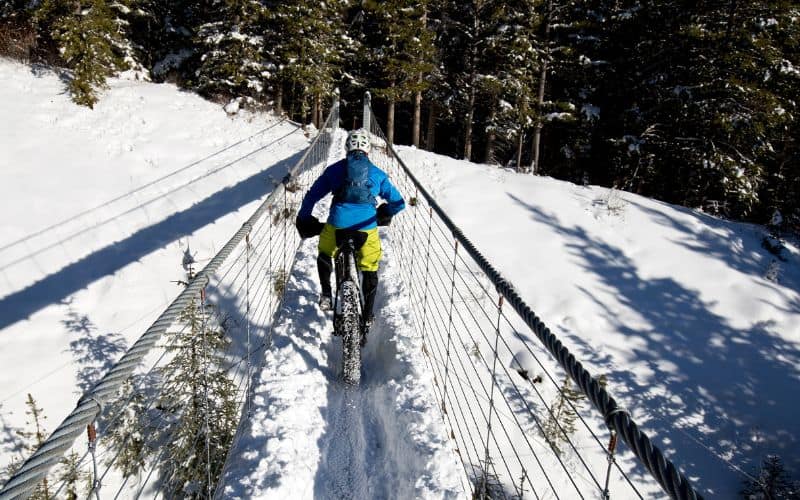
Because of their heavy build, they have enough weight to resist strong winds in bad weather.
And because of their decreased speed, you have enough time to avoid obstacles or figure out a way to go over them safely.
Finally, any discomfort felt while riding fat bikes can typically be fixed by getting a proper bike fit.
5/ Alternatives
Alright, so what about alternatives?
When it comes to mountain bikes, the main alternative (besides a fat bike) is a hybrid bike.
A hybrid bike is even lighter and thinner than a mountain bike, usually devoid of any kind of suspension system.

The most apparent difference between a hybrid bike and a mountain bike is the hybrid bike’s smooth tires, making them better suited for proper paths rather than off-road riding.
When it comes to fat bikes, the main alternative is a gravel bike.
A gravel bike is very similar to a fat bike in that it can ride on surfaces that a mountain bike can’t. It can even be turned into a fat bike since its frame allows for wide tires.

However, it is much faster than a fat bike and a mountain bike, making it more versatile.
Comparison Table
| Bike Type | Mountain Bike | Fat Bike |
| Usage | Difficult, rocky terrain that needs quick maneuvering, but NOT soft or slippery conditions. | Difficult terrain that doesn’t need as much speed, including soft and slippery conditions. |
| How They Work | Fast, lightweight, low-maintenance, easy-to-maneuver build, gives a bumpy ride and requires high skill. | Slow, heavyweight, high-maintenance, hard-to-maneuver build and gives a smooth ride even without much skill. |
| Affordability | Wider price range, with more options for spare parts and customization. | Large upfront investment, with fewer options for spare parts and customization. |
| Safety | Build can lead to more accidents and pain, especially in dangerous weather. | Build is safer for bad weather and obstacles and can be easily adjusted for comfort. |
| Alternatives | Hybrid bikes | Gravel bikes |
Conclusion
Overall, it can be harder to ride a fat bike and more expensive to get started.
However, it is also more versatile in terms of terrain, and it can be safer for you in the long run.
In the end, it all depends on what factors you value the most, but you can certainly mountain bike with a fat bike.
